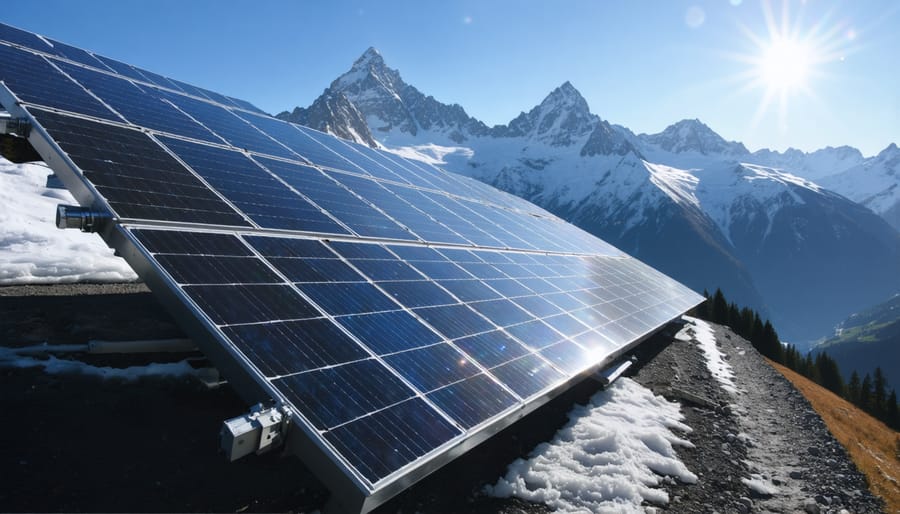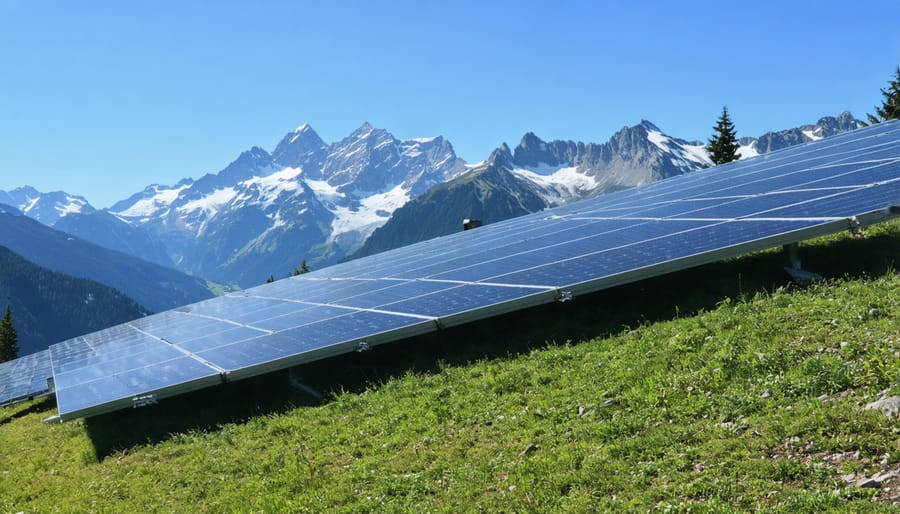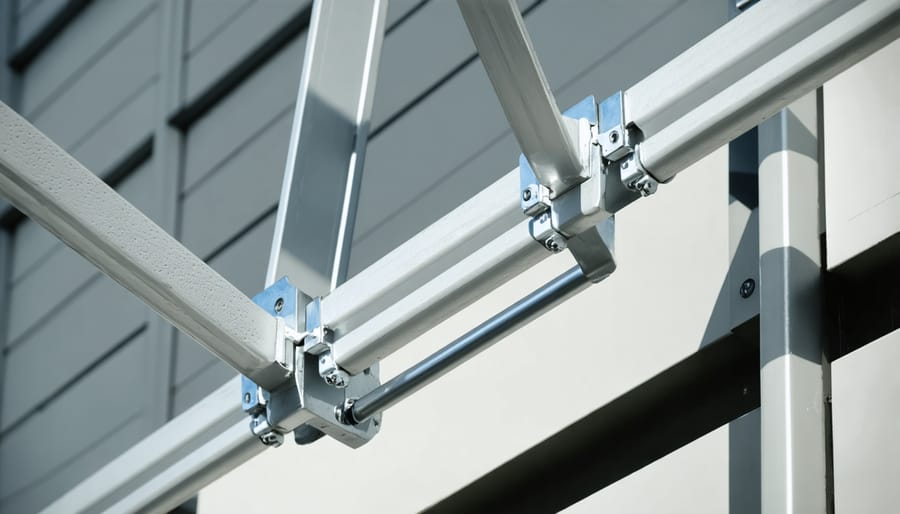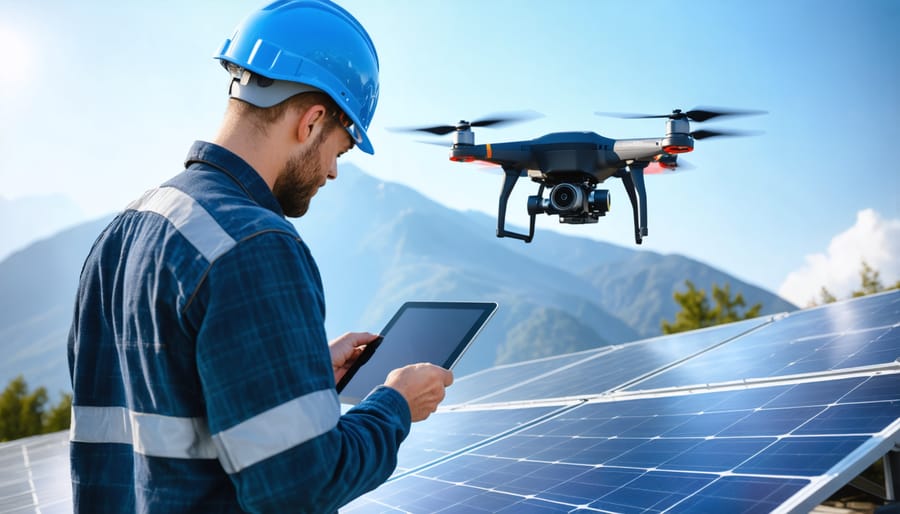Mountain Solar Power: Smart Solutions for High-Altitude Energy Success

Harness the untapped Europe’s solar potential in mountainous regions through innovative solar installations that defy altitude challenges. At elevations above 1,000 meters, solar panels generate up to 15% more electricity than at sea level, capitalizing on increased solar radiation and naturally cooler temperatures that enhance photovoltaic efficiency.
Mountain solar installations present unique advantages for sustainable energy generation, combining natural topographical benefits with cutting-edge technology. The reduced atmospheric interference at higher altitudes, coupled with reflection from snow coverage, can boost energy yield by up to 30% during winter months – making mountain solar particularly effective for year-round power generation in Alpine regions.
Despite challenging terrain, modern mounting systems and advanced panel technologies have revolutionized high-altitude solar deployment. These innovations enable robust installations that withstand extreme weather conditions while maximizing exposure to direct sunlight, even on steep slopes and variable terrain. For property owners and businesses in mountainous regions, this represents an unprecedented opportunity to lead Europe’s transition to renewable energy while achieving superior return on investment.
The Unique Advantages of Mountain Solar Installations

Higher Solar Radiation at Altitude
At higher altitudes, solar panels capture more intense solar radiation, leading to enhanced energy production efficiency. This phenomenon occurs because sunlight travels through less atmosphere before reaching mountain installations, experiencing reduced absorption and scattering along the way. For every 1,000 meters of elevation gain, solar radiation typically increases by 8-10%, offering significant advantages for mountain-based solar systems.
The thinner air at altitude contains fewer particles and pollutants that might otherwise block or diffuse sunlight. Additionally, mountain locations often sit above low-lying fog and cloud cover, ensuring more consistent exposure to direct sunlight. These conditions, combined with naturally cooler temperatures at elevation (which helps maintain optimal panel efficiency), create ideal circumstances for solar energy generation.
European mountain regions, particularly in the Alps and Pyrenees, benefit substantially from this increased solar radiation. Many high-altitude installations report energy yields 15-25% higher than identical systems at sea level, making mountain solar installations particularly attractive for both residential and commercial applications despite installation challenges.
Natural Cooling Effects
One of the most significant advantages of mountain solar installations is their naturally enhanced efficiency due to cooler temperatures at higher altitudes. Solar panels perform more efficiently in cooler conditions, and mountain environments provide this benefit naturally. For every degree Celsius above 25°C, solar panel efficiency typically decreases by 0.4-0.5%. In mountain settings, where average temperatures are notably lower than in valleys or urban areas, panels can maintain optimal performance levels for longer periods.
The cooling effect is particularly pronounced during summer months when conventional solar installations in lowland areas might suffer from heat-related efficiency losses. Mountain locations benefit from altitude-induced temperature drops, typically 0.6°C per 100 meters of elevation gain. This natural cooling, combined with better air circulation at higher altitudes, helps prevent overheating and maintains steady power output throughout the day.
Additionally, the clearer, thinner air at higher elevations reduces solar radiation absorption and heat build-up in the panels, contributing to more stable and efficient operation over their lifetime.
Overcoming Mountain Installation Challenges
Terrain Adaptation Technologies
Modern mountain solar installations rely on sophisticated terrain adaptation technologies to maximize energy generation in challenging topographic conditions. These cutting-edge solar solutions incorporate innovative mounting systems specifically designed for steep slopes and irregular surfaces.
Adjustable foundation systems utilize micropile technology, allowing secure anchoring in varied soil conditions while minimizing environmental impact. These foundations can be precisely leveled to create stable platforms even on significant inclines, ensuring optimal panel orientation regardless of the underlying terrain.
Advanced modular racking systems provide flexibility in panel positioning, with multi-axis adjustment capabilities that enable installers to achieve ideal solar exposure. These systems feature reinforced components designed to withstand increased wind loads common at higher altitudes, while their modular nature facilitates easier transportation to remote mountain locations.
Terrain-following mounting solutions employ sophisticated surveying and 3D modeling technologies to design installation layouts that conform to natural topography. This approach reduces the need for extensive groundwork while preserving local ecosystem integrity.
For areas with challenging access, lightweight composite materials and sectional design elements enable efficient component transportation and assembly. These materials offer excellent durability while reducing installation complexity and minimizing the need for heavy machinery in sensitive mountain environments.
Smart cable management systems accommodate elevation changes and variable distances between components, ensuring reliable connections across uneven terrain while protecting against weather-related stress and wildlife interference.
Weather-Resistant Solutions
In mountainous environments, solar installations must withstand particularly challenging extreme weather conditions, from heavy snowfall and ice formation to intense UV exposure and powerful winds. Our weather-resistant solutions incorporate several innovative features specifically designed for these demanding alpine settings.
High-grade tempered glass panels with enhanced structural integrity protect the photovoltaic cells while maintaining optimal light transmission. These panels undergo rigorous testing to ensure they can handle snow loads of up to 5400 Pa and withstand hailstones up to 25mm in diameter.
The mounting systems employ reinforced aluminum frames and stainless steel components, engineered to resist corrosion and maintain stability under high wind conditions. Advanced micro-crackling technology prevents snow accumulation, while specialized drainage channels efficiently manage moisture to prevent water damage and ice formation.
Thermal management systems are integrated to maintain consistent performance across extreme temperature variations. Smart monitoring solutions continuously track environmental conditions and system performance, automatically adjusting parameters to optimize energy generation while protecting the installation.
For areas prone to lightning strikes, comprehensive surge protection devices and enhanced grounding systems provide multiple layers of security. The entire system is backed by weather-sealed junction boxes and industrial-grade cables specifically designed for alpine environments.
These robust solutions ensure reliable operation throughout the year, maximizing energy production while minimizing maintenance requirements. Each component is selected and tested to maintain peak performance, even in the most challenging mountain conditions, providing dependable renewable energy solutions for alpine installations.
Optimizing Mountain Solar Performance
Advanced Mounting Systems
Installing solar panels in mountainous terrain requires specialized mounting systems designed to overcome steep slopes and challenging topography. These advanced mounting solutions combine innovative engineering with robust materials to ensure long-term stability and optimal energy production.
Adjustable slope brackets represent a significant advancement in mountain solar installations. These systems can accommodate gradients up to 45 degrees while maintaining panel efficiency through precise angle optimization. The brackets feature reinforced aluminum construction and additional support points to handle increased wind loads and snow accumulation common at higher altitudes.
Custom foundation systems play a crucial role in mountain installations. Advanced ground-screws and micro-pile foundations provide secure anchoring in rocky terrain, while specialized concrete footings offer stability on softer mountain soils. These foundations undergo rigorous geological assessment to ensure they meet local terrain conditions and safety requirements.
Modern mountain mounting systems also incorporate smart water management features. Elevated rack designs and integrated drainage channels prevent moisture accumulation and protect against erosion, particularly important in areas with heavy snowfall and spring thaws.
For extremely steep locations, terraced mounting configurations offer an effective solution. These systems create multiple levels of panels, maximizing available space while ensuring easy access for maintenance. The terraced approach also helps minimize visual impact on the mountain landscape, an important consideration for many European installations.
All mountain mounting solutions undergo extensive wind tunnel testing and comply with European structural standards, ensuring reliability in harsh alpine conditions.

Snow Management Features
Effective snow management is crucial for maintaining optimal performance of mountain solar installations. Modern solar systems incorporate several innovative features to handle snow accumulation efficiently. Self-cleaning panels with specialized coatings help prevent snow adhesion, while steeper installation angles of 35-45 degrees encourage natural snow sliding. These angles, particularly relevant in Alpine regions, balance optimal sun exposure with gravity-assisted snow removal.
Advanced heating elements integrated into panel frames can prevent snow buildup in critical areas. These systems activate automatically when sensors detect snow accumulation, ensuring continuous energy production during winter months. Some installations feature automated brushing systems that periodically clear snow without risking panel damage.
Smart monitoring systems play a vital role in snow management, utilizing weather data and real-time performance metrics to optimize panel operation. These systems can adjust panel angles in tracking installations to shed snow more effectively or activate heating elements preemptively before heavy snowfall.
For regions experiencing extreme winter conditions, bifacial panels prove particularly effective. Their dual-sided design captures reflected light from snow-covered surfaces, partially compensating for any temporary coverage on the front surface. Additionally, specialized mounting systems with enhanced structural support ensure panels can bear heavy snow loads while maintaining their optimal position for energy generation.
Monitoring and Maintenance
Modern mountain solar installations benefit from advanced remote monitoring systems that ensure optimal performance even in challenging alpine conditions. These sophisticated solutions allow system operators to track energy production, detect potential issues, and respond to maintenance needs promptly without frequent physical site visits.
Real-time monitoring platforms provide detailed insights into system performance, weather conditions, and component status. Property owners can access this information through user-friendly mobile apps or web interfaces, receiving instant notifications about system status and performance metrics.
Preventive maintenance strategies are crucial for mountain solar installations. Regular inspections should focus on snow load management, structural integrity checks, and electrical component assessment. During summer months, technicians should verify panel cleanliness, check for storm damage, and ensure all mounting systems remain secure against strong winds.
Winter maintenance requires special attention to snow accumulation and ice formation. Many modern mountain installations incorporate automated snow-shedding systems and heating elements to prevent excessive snow build-up. Additionally, accessibility plans should be established for emergency maintenance during harsh weather conditions.
Professional maintenance teams specialising in mountain installations typically schedule bi-annual comprehensive inspections. These visits include thorough system checks, calibration of monitoring equipment, and preventive measures to protect against seasonal challenges. This proactive approach helps maintain system efficiency and extends the installation’s operational lifespan while ensuring consistent energy production throughout the year.

Project Support and Implementation
Site Assessment Process
Professional site assessment for mountain solar installations requires a comprehensive evaluation of multiple geographical and environmental factors. Qualified engineers begin by analyzing the topographical features using advanced mapping tools and on-site surveys to determine optimal panel placement. They assess slope angles, surrounding peaks, and potential shading patterns throughout the year.
The evaluation process includes detailed solar radiation measurements specific to the mountain location, considering factors such as altitude, air density, and local weather patterns. Engineers also examine soil stability, bedrock composition, and drainage patterns to ensure secure foundation design for the installation.
Access routes for construction and maintenance are carefully mapped, while local grid connection possibilities are evaluated. Environmental impact assessments include wildlife corridors and vegetation analysis, ensuring compliance with Alpine region regulations. The team also considers snow load calculations, wind exposure patterns, and avalanche risk zones.
This thorough assessment typically takes several weeks to complete and results in a detailed feasibility report, including specific recommendations for system design, installation methodology, and necessary safety measures. This foundational step is crucial for ensuring long-term project success in challenging mountain environments.
Installation and Logistics
Installing solar systems in mountainous regions requires specialized expertise and careful planning. Experienced installers first conduct detailed site surveys, considering factors like slope angle, ground stability, and snow load capacity. These assessments determine the optimal mounting system and installation method for each unique location.
In mountain environments, installers typically use reinforced mounting structures designed to withstand extreme weather conditions. Heavy-duty foundation systems, such as concrete anchors or helical piles, ensure stability on steep terrain. Installation teams also implement enhanced waterproofing measures and specialized cable routing to protect against moisture and temperature fluctuations.
Access logistics play a crucial role in mountain installations. Teams often use specialized equipment like compact machinery and portable tools that can navigate narrow mountain roads. Some projects may require helicopter transport for materials in particularly remote locations. Installation scheduling typically accounts for seasonal weather patterns, with most work conducted during warmer months.
Safety measures are paramount, with installers using advanced climbing gear and following strict protocols for working on steep terrain. Post-installation, regular maintenance paths are established, ensuring safe access for future servicing needs.
Mountain solar installations represent a compelling solution for sustainable energy generation in Alpine regions, offering unique advantages despite their implementation challenges. The combination of higher solar radiation levels at elevation, reduced atmospheric interference, and natural cooling effects contributes to enhanced system efficiency. While careful planning is essential to address terrain challenges and weather considerations, modern engineering solutions and mounting technologies have made mountain solar installations increasingly viable and cost-effective.
For European property owners and businesses, mountain solar presents an opportunity to maximize renewable energy production while preserving valuable lowland space. With proper professional support, site assessment, and careful system design, mountain solar installations can deliver reliable, high-yield energy generation throughout the year. As technology continues to advance and installation expertise grows, mountain solar remains a forward-thinking choice for sustainable energy production in Alpine environments.
Leave a Reply